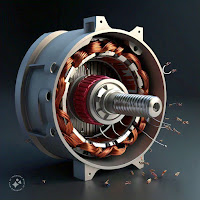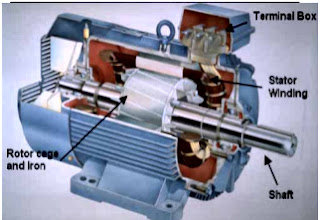Hello readers, I am here with the topic 'Electrical fuse' from power system. Let's start this, firstly we will discuss its contents:
INTRODUCTION :
A fuse is a short piece of metal, inserted in the circuit, which melts when excessive current flows through it and thus breaks the circuit. The fuse element is generally made of materials having low melting point, high conductivity and least deterioration due to oxidation e.g., silver, copper etc. It is inserted in series with the circuit to be protected. Under normal operating conditions, the fuse element is at a temperature below its melting point. Therefore, it carries the normal current without overheating. However, when a short-circuit or overload occurs, the current through the fuse increases beyond its rated value. This raises the temperature and fuse element melts (or blows out), disconnecting the circuit protected by it.
RELATABLE TERMS :
Current rating of fuse element :- It is the current which the fuse element can normally carry without overheating or melting. It depends upon the temperature rise of the contacts of the fuse holder, fuse material and the surroundings of the fuse.Fusing current :- It is the minimum current at which the fuse element melts and thus disconnects the circuit protected by it. Obviously, its value will be more than the current rating of the fuse element. For a round wire, the approximate relationship between fusing current I and diameter d of the wire is I = k d^(3/2),
where k is a constant, called the fuse constant. Its value depends upon the metal of which the fuse element is made. W.H. Preece found the value of k for different materials as given in the table below :
Cut-off current :- It is the maximum value of fault current actually reached before the fuse melts.
And it may be mentioned here also that outstanding feature of fuse action is the breaking of circuit before the fault current reaches its first peak. It gives the fuse a great advantage over a circuit breaker.
Pre-arcing time :- It is the time between the commencement of fault and the instant when cut off occurs. When a fault occurs, the fault current rises rapidly and produces heat in the fuse element. When the fault current reaches the cut off value, the fuse element melts and an arc is initiated. The time from the start of the fault to the instant the arc is initiated is known as pre-arcing time. That time is generally small : a typical value being 0·001second
Arcing time :- This is the time between the end of pre-arcing time and the instant when the arc is extinguished.
Breaking capacity :- It is the r.m.s. value of a.c. component of maximum prospective current that a fuse can deal with at rated service voltage.
FUSE ELEMENT MATERIAL :
The function of a fuse is to carry the normal current without overheating but when the current exceeds its normal value, it rapidly heats up to melting point and disconnects the circuit protected by it. In order that it may perform this function successfully, the material of fuse wire should have the following desirable characteristics :
- low melting point e.g., tin, lead.
- high conductivity e.g., silver, copper.
- free from deterioration due to oxidation e.g., silver.
- low cost e.g., lead, tin, copper.
The above discussion reveals that no material possesses all the characteristics. For instance, lead has low melting point but it has high specific resistance and is liable to oxidation. Similarly, copper has high conductivity and low cost but oxidises rapidly. Hence, a compromise is made in the selection of material for a fuse. The most commonly used materials for fuse element are lead, tin, copper, zinc and silver. For small currents upto 10 A, tin or an alloy of lead and tin (lead 37%, tin 63%) is used for making the fuse element. For larger currents, copper or silver is employed. It is a usual practice to tin the copper to protect it from oxidation. Zinc (in strip form only) is good if a fuse with considerable time-lag is required i.e., one which does not melt very quickly with a small overload.
The present trend is to use silver despite its high cost due to the following reasons :
- It is comparatively free from oxidation.
- It does not deteriorate when used in dry air.
- The coefficient of expansion of silver is so small that no critical fatigue occurs. Therefore, the fuse element can carry the rated current continuously for a long time.
- The conductivity of silver is very high.
TYPES OF FUSES :
Fuses may be categorised as : (i) Low voltages fuses (ii) High voltage fuses
(i). Low voltage fuses : It can be also categorised into two as:
- Semi-enclosed rewireable fuse
- High rupturing capacity (H.R.C.) cartridge fuse.
Semi-enclosed rewireable fuse: Rewireable fuse (also known as kit-kat type) is used where low values of fault current are to be interrupted. It consists of (i) a base and (ii) a fuse carrier. The base is of porcelain and carries the fixed contacts to which the incoming and outgoing phase wires are connected. The fuse carrier is also of porcelain and holds the fuse element (tinned copper wire) between its terminals. The fuse carrier can be inserted in or taken out of the base when desired. When a fault occurs, the fuse element is blown out and the circuit is interrupted. The fuse carrier is taken out and the blown out fuse element is replaced by the new one. The fuse carrier is then reinserted in the base to restore the supply. This type of fuse has two advantages. Firstly, the detachable fuse carrier permits the replacement of fuse element without any danger of coming in contact with live parts. Secondly, the cost of replacement is negligible.
High-Rupturing capacity (H.R.C.) cartridge fuse : The primary objection of low and uncertain breaking capacity of semi-enclosed rewireable fuses is overcome in H.R.C. cartridge fuse. It consists of a heat resisting ceramic body having metal end-caps to which is welded silver current-carrying element. The space within the body surrounding the element is completely packed with a filling powder. The filling material may be chalk, plaster of paris, quartz or marble dust and acts as an arc quenching and cooling medium.
(ii). High voltage fuses : The low-voltage fuses cannot be successfully used on modern high voltage circuits. Intensive research and supply by engineers has led to the development of high voltage fuses. Some of the high voltage fuses are :
Cartridge type: Similar in general construction to the low voltage cartridge type except that special design features are incorporated. Some designs employ fuse elements wound in the form of a helix so as to avoid corona effects at higher voltages. On some designs, there are two fuse elements in parallel ; one of low resistance (silver wire) and the other of high resistance (tungsten wire). Under normal load conditions, the low resistance element carries the normal current. When a fault occurs, the low-resistance element is blown out and the high resistance element reduces the short-circuit current and finally breaks the circuit. High voltage cartridge fuses are used upto 33 kV with breaking capacity of about 8700 A at that voltage.
Liquid type: These fuses are filled with carbon tetrachloride and have the widest range of application to H.V. systems. They may be used for circuits upto about 100 A rated current on systems upto 132 kV and may have breaking capacities of the order of 6100 A.
It consists of a glass tube filled with carbon tetrachloride solution and sealed at both ends with brass caps. The fuse wire is sealed at one end of the tube and the other end of the wire is held by a strong phosphor bronze spiral spring fixed at the other end of the glass tube. When the current exceeds the prescribed limit, the fuse wire is blown out. As the fuse melts, the spring retracts part of it through a baffle (or liquid director) and draws it well into the liquid. The small quantity of gas generated at the point of fusion forces some part of liquid into the passage through baffle and there it effectively extinguishes the arc.
Metal clad fuses: Metal clad oil-immersed fuses have been developed with the object of providing a substitute for the oil circuit breaker. Such fuses can be used for very high voltage circuits and operate most satisfactorily under short-circuit conditions approaching their rated capacity
ADVANTAGES :
- It is the cheapest form of protection available.
- It requires no maintenance.
- Its operation is inherently completely automatic unlike a circuit breaker which requires an elaborate equipment for automatic action.
- It can break heavy short-circuit currents without noise or smoke.
- The smaller sizes of fuse element impose a current limiting effect under short-circuit conditions.
- The inverse time-current characteristic of a fuse makes it suitable for overcurrent protection.
- The minimum time of operation can be made much shorter than with the circuit breakers.
DISADVANTAGES :
- Considerable time is lost in rewiring or replacing a fuse after operation.
- On heavy short-circuits, discrimination between fuses in series cannot be obtained unless there is sufficient difference in the sizes of the fuses concerned.
- The current-time characteristic of a fuse cannot always be co-related with that of the protected apparatus
RATINGS :
(i) Current Ratings :- The current rating printed on a fuselink applies only at temperatures below a particular values. It is obviously undesirable to have a proliferation of current ratings and therefore particular or preferred ratings are specified in standards. There is a general tendency to follow the IEC standards. For example fuses with ratings from 10A to 100A are produced for 10A, 12A, 16A, 20A, 25A, 32A, 40A, 50A, 63A, 80A and 100A.
(ii) Voltage Ratings :- The rated voltage of a fuse is the nominal voltage for which it was designed. Fuselinks will perform satisfactorily at lower voltages, but at much lower voltages, the reduction in current caused by the resistance of the fuselinks should be considered. In the case of A.C. ratings, the R.M.S. symmetrical value is given, and for D.C. ratings the mean value, including ripple, is given.
(iii) Frequency Ratings :- Fuses are most commonly used in A.C. circuits with frequency 50Hz or 60Hz and a fuse designed for one of these frequencies will generally operate satisfactorily at the order. If the arc extinguishes at current zero, then the maximum arcing time on a symmetrical fault will be 10ms at 50Hz and 8ms at 60Hz.
(iv) Breaking Capacity :- The breaking capacity of a fuse is the current which can be interrupted at the rated voltage. The required breaking capacity will depend upon the position of the fuse in the supply system. For instance, 6kA may be suitable for domestic and commercial applications, but 80kA is necessary at the secondary of a distribution transformer.
TESTS :
(i) Type Tests :- Before production of a type of fuselink commences, type tests are performed to ensure that preproduction fuselink samples comply with relevant national or international standards. Measurements of power dissipation, time current characteristics, overload withstand capability, breaking capacity and resistance are included in these type tests.
(ii) Production Tests :- Routine testing of many important fuse characteristics is not possible because tests, such as breaking capacity, are destructive. The quality of fuselinks depends upon the quality of the components supplied to the fuse manufacturer. Other tests are made in the case of specialised fuselinks. For example, the conditions of the elements in a high-voltages fuselink is examined using X-ray photography.
(iii) Site Tests :- Before use, every fuselinks should be checked visually for cracks and tightness of endcaps and the resistance should be checked. It should also be checked that the ratings, especially current, voltages, breaking capacity and time-current characteristics, are correct for the application.


























